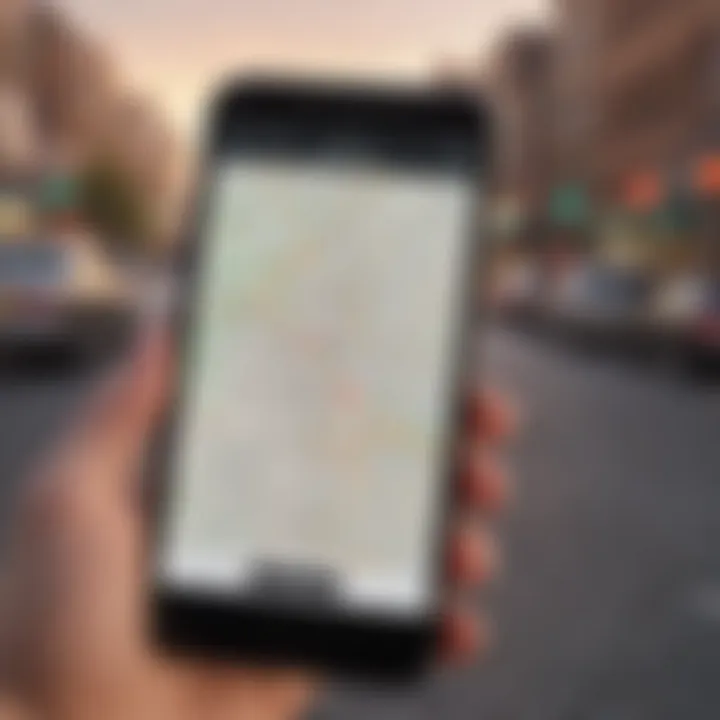How to Find Your iPhone Using a Mac


Product Overview
When it comes to the modern tech landscape, locating your iPhone through a Mac has become an essential skill. Apple’s integration of its devices allows users to seamlessly manage their digital lives, and the ability to track a misplaced iPhone enhances that convenience. So, let’s break it down a bit.
In essence, iPhone and Mac work together under the umbrella of Apple's ecosystem. This integration showcases how design and functionality can go hand-in-hand. The iPhone itself is a marvel of technology, with its sleek design and robust build quality. Whether it’s the powerful A-series chip inside or the vivid display that catches your eye, it’s more than just a phone; it’s a tool for your everyday life.
Key Features and Specifications
- Location Services: The iPhone utilizes GPS, Wi-Fi, and cell towers to triangulate your position accurately.
- Find My App: This app allows users to locate their device, play a sound, and even remotely lock it.
- iCloud Integration: Synchronizes your devices so that you have access to your information from anywhere, at any time.
Design and Aesthetics
The current iPhone models boast a sleek and modern aesthetic. With edge-to-edge displays and a variety of colors, they’re not just devices; they're also fashion statements. The design focuses on user experience, ensuring that navigation through the interface feels intuitive and fluid.
Performance and User Experience
When it comes to performance, the synergy between iPhone and Mac stands out. Users often mention how connecting these devices enhances productivity and ease of use. For instance, locating a lost iPhone from your Mac is a task that can be completed in mere minutes, thanks to the efficient integration.
Performance Benchmarks
From a performance standpoint, Apple's chips are renowned for their speed and efficiency. The processing capabilities allow the Find My app to quickly ascertain the mobile’s whereabouts without unnecessary lag. This responsiveness is a hallmark of Apple's design philosophy - keeping things user-friendly and quick.
User Interface and Software Capabilities
Apple's user interface is lauded for its simplicity and elegance. Navigating through the Find My app on a Mac is straightforward; users can immediately see the devices linked to their Apple ID and choose the one they wish to locate. This intuitive setup streamlines the experience significantly.
User Experiences and Feedback
Although tech enthusiasts often rave about the seamless experience, some users have voiced concerns over the accuracy of location tracking. The tech landscape, however, continuously evolves, with updates often addressing such issues.
Comparison with Previous Models or Competitors
Apple's ongoing commitment to innovation is visible when comparing newer iPhone models with their predecessors. Each iteration offers new enhancements that make locating the device even more reliable.
Advancements and Improvements from Previous Models
Earlier models had basic tracking features, while the modern iPhone incorporates advanced technology like U1 chip enabled Ultra Wideband, improving the precision of location services.
Competitive Analysis with Other Similar Products
In a world bustling with competitors, Apple’s integration remains unmatched. Other brands like Samsung or Google offer tracking services, yet they lack the holistic usability experienced within the Apple ecosystem.
Value Proposition
Given the ease with which users can locate their iPhone through their Mac, the value proposition becomes apparent. Investing in Apple’s products fundamentally adds layers of convenience to daily life.
Tips and Tricks
To make the most of your Apple devices, here are some handy tips for locating your iPhone from your Mac:
- Stay Logged In: Ensure you are logged into your Apple account on both devices.
- Enable Find My iPhone: Double-check that this option is enabled on your iPhone.
- Utilize iCloud: Familiarize yourself with the iCloud settings for streamlined access to the Find My app.
"The Find My app is truly the backbone of locating devices in the Apple ecosystem, connecting all dots effortlessly."
Hidden Features and Functionalities
One lesser-known tip is using the 'Notify When Found' feature within the Find My app, ensuring you get an alert once your phone checks in.
Troubleshooting Common Issues
If unable to locate your device, check that the iPhone has a network connection. Sometimes, a simple restart can restore your ability to track.
Latest Updates and News
Apple continually rolls out updates, adding features and tweaks that enhance existing functionalities. Stay tuned for news regarding the upcoming iOS releases and potential new features related to device tracking and Find My app improvements.
Recent Developments in Software Updates
The most recent iOS updates have focused on improving location accuracy and functionality of the Find My app.
Industry News and Rumors Surrounding Upcoming Products
As always, there are whispers about future iPhone releases which may expand upon these tracking capabilities even further.
Events and Announcements from Apple


Keep an eye on Apple's events that showcase innovative features, often revealing insights that tech enthusiasts find invaluable.
Foreword
In today’s fast-paced world, the anxiety associated with losing a smartphone is a palpable fear for many. An iPhone, often regarded not just as a communication device, but as a repository of personal memories, essential contacts, and, increasingly, security information, holds a significant place in our daily lives. Locating an iPhone through a Mac offers a lifeline for users, enabling them to regain control over what might feel like a lost fragment of their reality.
Technology, especially from big players like Apple, comes intertwined with its ecosystem, offering seamless integration between devices. This connection not only enhances user experience but also provides intelligent tools to address common pain points such as misplacing an iPhone. The ability to track a device can save hours of searching, and peace of mind is something that cannot be underestimated.
Purpose of the Article
The primary aim of this article is to demystify the various methods available for locating an iPhone using a Mac. With detailed steps and insights into the built-in applications developed by Apple, readers will grasp how straightforward it can be to retrieve their device. Each section will delve into the functionality of features, like Find My, which have been designed to serve users efficiently, with minimal hassle.
By laying out clear instructions, tips, and resources, this guide acts as a roadmap for those who might find themselves in dire straits. Whether it’s providing a quick fix or elaborating on advanced options, the article is tailored to meet the needs of those familiar with Apple’s world, as well as newcomers trying to grasp the intricacies of their devices.
Importance of Locating Your iPhone
Understanding the ways to locate your iPhone is as crucial as knowing how to operate the device itself. In moments of panic—when a phone goes missing—having the knowledge of quick access tools can mean the difference between despair and success. According to various studies, a significant number of mobile phones are lost annually, reflecting the urgency of this topic.
This ability touches on several key aspects:
- Security: A lost iPhone can lead to vulnerabilities if it falls into the wrong hands. Knowing how to quickly locate your device helps mitigate risks.
- Convenience: Misplacing a phone is more common than one might think. Effective location methods streamline daily routines and alleviate stress.
- Integration with other tools: The connection between an iPhone and a Mac expands beyond mere tracking; various functionalities enhance user experience, making life easier in multiple ways.
Ultimately, the relevance of knowing how to locate an iPhone seamlessly ties into broader discussions of security, convenience, and the holistic benefits of being part of Apple's ecosystem. This article sets the stage for not only understanding these features but appreciating the peace of mind that comes with mastering them.
Understanding Apple's Ecosystem
Apple's ecosystem, comprising devices and services seamlessly tied together, not only enhances user experiences but also significantly simplifies tasks such as locating an iPhone using a Mac. This interconnectedness is a hallmark of Apple's design philosophy. It allows users to navigate effortlessly through their devices, ensuring that accessing and managing information is quick and efficient.
Key Elements of the Ecosystem
- Device Integration: Each Apple product, from the iPhone to MacBook, is engineered to work in harmony. This is evident in features like Handoff and Continuity, which allow users to switch devices without losing their work. You can start a task on your iPhone and pick it up on your Mac, keeping a smooth workflow.
- Shared Services: iCloud stands out as a cornerstone of the ecosystem, providing a common ground for syncing data across devices. With iCloud, you can manage contacts, calendars, photos, and finding lost devices all from a single interface.
The convenience of being able to locate your iPhone from a Mac without cumbersome steps is a crucial advantage in Apple's ecosystem. It’s a lifeline, especially for those often on the go or engrossed in work, allowing quick access to the ‘Find My’ features without fussing around with multiple apps or logins.
Also noteworthy is the security aspect – by centralizing device management, Apple can implement stronger security protocols, keeping user data safe while also providing powerful tools to find lost devices.
Integration between iPhone and Mac
Integrating the iPhone and Mac makes finding an iPhone feel like a walk in the park. With features designed to operate fluidly between devices, this connection enriches the user experience.
- Unified Account Management: When you sign into your Mac with the same Apple ID as your iPhone, a world of interconnected services becomes accessible. Every setting, from managing alerts to tracking the location of your iPhone, can be accessed with a few clicks.
- 'Find My' Functionality: With a simple tap or a couple of clicks, you can activate features like 'Find My iPhone' directly from your Mac. This reliability is not just about convenience; it’s about being responsive when an iPhone goes missing.
The seamless integration saves time and frustration. One doesn't have to dig through settings or apps that are not working in tandem. Rather, it feels more like a team effort with the devices working together efficiently.
Role of iCloud in Device Location
When discussing locating devices, one cannot overlook the pivotal role of iCloud. This service acts as the backbone for numerous features across Apple devices, and locating your iPhone is no exception.
- Centralized Location Data: iCloud stores and manages your device’s location data, ensuring it’s accessible anytime you need it. If you've ever wondered how an iPhone can be tracked even when it appears turned off, that’s iCloud working behind the scenes to offer last-known locations.
- Security and Privacy Features: iCloud offers robust security measures to ensure that your information is safeguarded. For instance, when you enable ‘Find My iPhone,’ it uses encryption to safeguard your data while sharing your location with your other Apple devices. This integration ensures you know where your iPhone is, all while keeping your personal information confidential.
"Using iCloud not only simplifies managing multiple devices but also enhances your ability to recover lost ones, making it an indispensable part of the Apple experience."
Thus, the combination of iCloud and the integrated device structure provides a solid foundation for users, making it both practical and easy to locate an iPhone from a Mac.
Finding Your iPhone Using 'Find My'
Locating a misplaced or lost iPhone can be a daunting task, but with Apple’s built-in feature Find My, the process becomes significantly easier. This method leverages the seamless integration of Apple devices, allowing you to track down your smartphone efficiently through your Mac. In this section, we will explore the intricacies of Find My, its advantages, and the straightforward steps you can take to make the most out of this indispensable tool.
The Find My app is not just a tool for locating lost devices; it’s a robust service that enhances user security and peace of mind. When you have Find My activated on your iPhone, your device leverages GPS along with Wi-Fi and Bluetooth signals. The culmination of these technologies allows you to pinpoint your phone’s location almost down to the meter. You might find it reassuring to know that being able to track your device can save a lot of headaches in the long run.
Setting Up Find My iPhone
Before you can utilize the full potential of Find My, it's crucial to set it up properly on your iPhone. To do this:
- First, open the Settings app.
- Tap on your name at the top to access your Apple ID settings.
- Select iCloud and scroll to find Find My iPhone.
- Turn on Find My iPhone and, if prompted, enable Share My Location.
This simple setup process ensures that your iPhone is ready to be located at a moment’s notice. Leaving these features active could prove invaluable, especially if you find yourself misplacing your device often. Remember, the more proactive you are about these settings, the less confusing things can get down the road.
Accessing Find My on Mac
Once Find My is set up on your iPhone, you’ll want to know how to access it from your Mac. This is where the true integration of Apple’s ecosystem shines through. Here’s how you can do it:
- Open Find My from the Applications folder or by searching it through Spotlight.
- Sign in with your Apple ID, if prompted.
- Upon entering the app, you will notice various options displayed on the side including Devices and People.
Navigating through the Find My interface on Mac is quite intuitive, but being familiar with its layout can certainly ease any confusion. You’ll find that the user experience mirrors that on your iPhone, making it easier to switch back and forth between devices.


Locating Your iPhone via Mac
To locate your iPhone using your Mac, follow these steps once you’re in the Find My app:
- Click on the Devices tab to reveal a list of all devices associated with your Apple ID.
- Search for your iPhone in the list and click on its name.
- The map will populate with the current location of your device, displayed as a green dot. If your device is nearby, you can opt to play a sound, which can help locate it if it’s hidden under a cushion or stuck in a bag.
- If the device is not in your local vicinity, you can view its last known location.
Using the Find My application effectively can not only save you time but also prevent potential security risks should your device fall into the wrong hands.
Additionally, understanding how to navigate these features can be a game-changer for anyone who frequently juggles multiple Apple devices. The seamless connectivity between your devices is one of the many perks of being within Apple’s ecosystem that not every tech user gets to enjoy.
Exploring Alternatives to 'Find My'
In the realm of locating your iPhone, Apple's built-in tools, particularly 'Find My', often take center stage. However, there are times when this primary option may not suffice. Perhaps you’ve experienced connectivity issues, or maybe you just want a backup plan. Exploring alternatives to 'Find My' is crucial in ensuring that you can track down your device when needed. This section delves into two notable alternatives: using iCloud.com and utilizing third-party applications.
Using iCloud.com
Accessing iCloud.com is a straightforward alternative that empowers you to locate your iPhone from any browser. Just imagine being at a friend's house and realizing you've left your phone behind. Instead of flustered searching, a quick visit to iCloud could save the day. Here’s how it works:
- Open your web browser and go to iCloud.com.
- Log in with your Apple ID and password. (Make sure you remember that pesky password!).
- Click on "Find iPhone". This feature is seamlessly integrated into iCloud.
- Select your iPhone from the list of devices. This is where the magic happens, as you'll see its location on a map.
"Even if the phone is offline, iCloud illustrates the last known location, valuable when your device has run out of juice."
Utilizing iCloud.com also provides options to play a sound on your device, activate Lost Mode, or even erase your iPhone remotely if you fear it’s fallen into the wrong hands. It’s like having a digital safety net, all from the comfort of your laptop.
Utilizing Third-Party Applications
For those looking to expand their arsenal, third-party applications can be invaluable. These apps offer various features that might not only assist in finding your iPhone but also enrich your overall digital experience. Here are two noteworthy options:
- Lookout Mobile Security: Besides tracking your device, Lookout provides a comprehensive suite of security features, including breaches alerts and backup options.
- Prey Anti Theft: This application goes beyond just locating your phone. It allows you to remotely access your device’s camera, enabling you to snap a picture of who might be using your phone.
When using these apps, it’s prudent to check the reviews and ensure they're trustworthy. Many offer free versions, allowing you to test their reliability before committing.
In summary, while 'Find My' is a powerful tool, knowing how to tap into iCloud.com and reliable third-party applications ensures you’re not left high and dry when your iPhone goes missing. Being prepared means having multiple options at your fingertips, making the task of locating your device much less stressful.
Troubleshooting Common Issues
When trying to find your iPhone using a Mac, issues can arise that may hinder the process. Addressing these challenges is crucial because locating a lost device often relies on specific settings being correctly configured. This section explores common problems encountered with Apple’s Find My service and offers solutions.
Problems with Find My Activation
One of the primary hurdles users face is issues related to activating Find My iPhone. This tool is essential for tracking your device, and without it, the process becomes significantly more complicated. If Find My iPhone is not set up on the device before it's lost, recovery options dwindle.
To activate Find My, ensure the following steps are taken:
- Open your iPhone settings and tap on your name at the top.
- Select "iCloud" and scroll down to "Find My iPhone."
- Toggle the switch to enable this feature.
Failure to do these steps can lead to stress when trying to locate a lost phone. Remember, enabling Find My requires a stable internet connection and iCloud to be set up with your Apple ID.
Moreover, it’s worth noting that sometimes, users mistakenly disable this feature or forget to turn it on after a software update.
If you run into troubleshooting problems when trying to activate Find My on the iPhone, consider:
- Restarting the device. A simple reboot can solve many glitches.
- Checking for any software updates, as Apple regularly releases fixes that could resolve activation issues.
- Verifying that your Apple ID is still valid and active; if not, perform any necessary recovery steps.
iPhone Not Appearing on Mac
Another common issue users encounter is the iPhone not showing up on the Mac despite attempts to locate it. This can be frustrating and disheartening, especially when you've taken all the correct steps.
Here are some key points to troubleshoot:
- Connection issues: First off, check your internet connection on both devices. A spotty or intermittent connection can prevent the devices from communicating effectively.
- iCloud Login: Ensure that both the iPhone and the Mac are logged into the same iCloud account. If you’ve got multiple accounts, it’s easy to mix things up. It may help to log out and back in on both devices.
- System Notifications: Sometimes, macOS might not show your iPhone due to notification settings or if the device is set to ignore notifications from Find My. Adjust your notification settings accordingly.
Always ensure that your devices are adequately paired with your Apple ID; otherwise, tracking becomes complex.
- Check Find My Settings: On your iPhone, go to Settings > [Your Name] > iCloud > Find My iPhone to double-check if everything is correctly activated.
These issues can complicate the locating process, but with the right approach, they can often be solved. Staying proactive about checking settings will lead to smoother experiences in the future.
Enhancing Device Security
In today’s world, safeguarding your iPhone is as crucial as the device itself. Enhancing device security not only provides peace of mind but also ensures that your personal information is protected from prying eyes. With the advent of various security threats, understanding and implementing proper security measures is paramount. For Apple users, there are built-in features intended to keep your devices secure, especially when you consider that many users are not just Apple enthusiasts but also utilize their devices for sensitive tasks.
When exploring the security features, two main aspects stand out: Two-Factor Authentication and the importance of keeping devices updated. Both of these elements not only bolster the security of your devices but also reflect on the broader ramifications of how data is managed within Apple's ecosystem.
Enabling Two-Factor Authentication


When it comes to securing your Apple devices, enabling two-factor authentication (2FA) is a must. This feature adds another layer of protection by requiring not just a password, but also a secondary form of verification when signing into your Apple ID on a new device. Here’s why it matters:
- Extra layer of security: If someone happens to discover your password, they still wouldn’t be able to access your account without the second verification step.
- Your control: This feature allows you to determine which devices can access your Apple ID, which adds to peace of mind.
To enable 2FA, you can follow these steps:
- Open Settings on your iPhone.
- Tap your name at the top of the screen.
- Select Password & Security.
- Tap Turn On Two-Factor Authentication.
- Follow the on-screen prompts to complete the setup.
This straightforward process may seem like a small hurdle, but it can significantly reduce the chance of unauthorized access to your accounts.
Keeping Your Devices Updated
In the tech world, neglecting updates can be like leaving your front door unlocked. Keeping your devices updated ensures that you have the latest security features and enhancements provided by Apple. Software updates often include critical security patches that protect the system against new vulnerabilities.
Regularly updating not only strengthens your device’s security but also enhances performance and introduces new features, making your experience seamless. Here’s how to manage updates:
- Automatic updates: You can set your devices to update automatically to reduce the risk of missing important updates.
- Manual checks: If you prefer a hands-on approach, go to Settings > General > Software Update to manually initiate updates.
Remember, an updated device is a secure device. Don’t overlook this simple yet effective step in maintaining your device's safety.
Neglecting the software on your devices could lead to significant risks, especially in a world filled with cyber threats. Whether you’re handling personal data or accessing corporate information, ensuring your software is current is as important as locking the doors to your home.
Considerations for Lost Mode
When it comes to safeguarding your iPhone, activating Lost Mode is a critical step that not all users consider. Not only does Lost Mode enhance your chances of retrieving a misplaced device, but it also serves as a way to protect your personal data from prying eyes. In this section, we will dive into the importance of this feature, discussing its benefits and the considerations to keep in mind when utilizing it.
Activating Lost Mode
Activating Lost Mode is a breeze, especially if you've been using Find My iPhone through your Mac. Here’s how you can activate it:
- Open 'Find My' on your Mac: Click on the Find My app icon, which you can find in the Applications folder or from the dock.
- Select Your iPhone: Within the app, you’ll see a list of devices. Click on your iPhone—you'll know it is the right one by checking the last known location displayed on the map.
- Activate Lost Mode: Once you select your device, you’ll see an option labeled Activate Lost Mode. Click it and follow the prompts. You’ll be asked to enter a phone number and a message that will be displayed on the lock screen of your lost iPhone. This can be particularly useful for anyone who finds your device, giving them a way to contact you.
- Confirm Activation: After entering the necessary details, hit Activate. You should see a confirmation on your Mac that Lost Mode is successfully activated.
Activating Lost Mode not only locks your iPhone but also displays your custom message, ensuring the finder has a way to return it while protecting your information.
Impact of Lost Mode on Notifications
One aspect that often gets overlooked is how activating Lost Mode affects notifications. When your iPhone is in Lost Mode, it’s worth noting a few important factors:
- Silenced Notifications: Incoming calls and notifications are silenced to prevent them from being distracting. If the phone is turned off or out of battery, it will remain in Lost Mode when turned back on.
- Locked Screen: Your iPhone’s screen will present the message you set during activation, giving any potential good Samaritans a clear way to reach out while keeping your data secure.
- Limited Access: Even if someone were to try and access your information, they wouldn't be able to unlock the device, which is a significant safety measure.
Overall, keeping Lost Mode activated not only secures your personal data but also controls how notifications are managed on your device to minimize distraction while you try to find it. Each of these points reinforces the necessity of Lost Mode as a tool for both recovery and security.
Finale
The conclusion serves as a pivotal aspect of this article. It succinctly encapsulates the key insights and methods discussed, reinforcing the significance of having a clear roadmap for locating an iPhone with a Mac. This is not just about technology; it's about empowering users within the sprawling Apple ecosystem.
Recap of Key Methods
In summary, we dissected multiple approaches for finding an iPhone using a Mac:
- Find My iPhone: The cornerstone tool, integrating smoothly into your Mac, allows quick access for tracking.
- iCloud.com: A useful alternative when your Mac doesn’t play nice with the Find My app.
- Third-Party Applications: Sometimes, these can offer additional features that Apple's built-in tools don’t cover.
Mastering these methods is crucial, whether it’s to retrieve a misplaced device or to ensure ongoing security. A well-informed user is less likely to find themselves in a panic over a lost iPhone.
Final Thoughts on iPhone Recovery
Navigating the nuances of finding an iPhone from a Mac is more than a mere technical skill; it’s about fostering a secure environment within one’s digital life. As reliance on technology waxes, being prepared with recovery methods cultivates peace of mind.
Whether it's family, work, or personal life, your device acts as a lifeline. Thus, take these methods to heart, arm yourself with knowledge, and elevate your confidence in using Apple’s tools effectively. Remember, being proactive about technology makes all the difference.
References and Further Reading
In today’s tech-driven world, knowing how to locate an iPhone from a Mac is just one piece of the puzzle. But once you’ve grasped the basics, it’s beneficial to dive deeper into References and Further Reading. This ensures you stay updated and equip yourself with comprehensive resources to enhance your understanding of Apple’s ecosystem.
Official Apple Support Resources
Apple offers an array of support resources that are indispensable for anyone keen on mastering their devices. The Apple Support website serves as a treasure trove of information. Users can find everything from setup guides to troubleshooting tips. For example, if someone encounters issues activating , a quick check in the support section can often resolve it.
These guides are written clearly, addressing common concerns while offering step-by-step procedures. Apple also updates these resources regularly, aligning them with software updates. Furthermore, having access to Apple’s official documentation breeds confidence, ensuring users receive the most accurate and precise guidance. Here are some useful links to explore:
Community Forums and Insights
While the official resources are top-notch, community forums like those on Reddit or dedicated Apple user sites can provide insights that the manufacturer’s support sometimes might not capture. The beauty of community interaction is the diverse range of experiences. For instance, users often share personal anecdotes about lost iPhones and what worked or didn’t for their unique situations.
Additionally, these discussions often highlight common pitfalls or tricks that official resources overlook. Engaging with fellow Apple enthusiasts can help you learn tips like optimizing location services or adjusting settings without the worry of overcomplicating things.
Participating in forums also facilitates knowledge exchange and creates a sense of community among Apple users. To get started, consider visiting:
"Resources are everywhere, but it's how you weave them into your understanding that makes all the difference."



